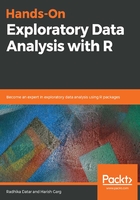
What this book covers
Chapter 1, Setting Up Our Data Analysis Environment, introduces the overall goal of this book. This chapter stipulates how exploratory data analysis benefits business and has a significant impact across almost all verticals.
Chapter 2, Importing Diverse Datasets, demonstrates practical, hands-on code examples on reading in all kinds of data into R for exploratory data analysis. This chapter also covers how to use advanced options while importing datasets such as delimited data, Excel data, JSON data, and data from web APIs.
Chapter 3, Examining, Cleaning, and Filtering, introduces how to identify and clean missing and erroneous data formats. This chapter also covers concepts such as data manipulation, wrangling, and reshaping.
Chapter 4, Visualizing Data Graphically with ggplot2, demonstrates how to draw different kinds of plots and charts, including scatter plots, histograms, probability plots, residual plots, boxplots, and block plots.
Chapter 5, Creating Aesthetically Pleasing Reports with knitr and R Markdown, explains how to use RStudio to wrap your code, graphics, plots, and findings in a complete and informative data analysis report. The chapter will also look at how to publish these in different formats for different audiences using R Markdown and packages such as knitr.
Chapter 6, Univariate and Control Datasets, takes a real-world univariate and control dataset and runs an entire exploratory data analysis workflow on it using the R packages and techniques.
Chapter 7, Time Series Datasets, introduces a time series dataset and describes how to use exploratory data analysis techniques to analyze this data.
Chapter 8, Multivariate Datasets, introduces a dataset from the multivariate problem category. This chapter explains how to use exploratory data analysis techniques to analyze this data, as well as how to use the exploratory data analysis techniques of the star plot, the scatter plot matrix, the conditioning plot, and their principal components.
Chapter 9, Multi-Factor Datasets, introduces a multi-factor dataset and explains how to use exploratory data analysis techniques to analyze this data.
Chapter 10, Handling Optimization and Regression Data Problems, introduces a dataset from the regression problem category and describes how to use exploratory data analysis techniques to analyze this data. It also shows how to learn and apply these exploratory data analysis techniques.
Chapter 11, Next Steps, covers how to build a roadmap for yourself to consolidate the skills you have learned in this book and gain further expertise in the field of data science with R.